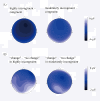ERP correlates of social conformity in a line judgment task
- PMID: 22554347
- PMCID: PMC3405473
- DOI: 10.1186/1471-2202-13-43
ERP correlates of social conformity in a line judgment task
Abstract
Background: Previous research showed that individuals have a natural tendency to conform to others. This study investigated the temporal characteristics of neural processing involved in social conformity by recording participants' brain potentials in performing a line judgment task. After making his initial choice, a participant was presented with the choices of four same-sex group members, which could be congruent or highly or moderately incongruent with the participant's own choice. The participant was then immediately given a second opportunity to respond to the same stimulus.
Results: Participants were more likely to conform to the group members by changing their initial choices when these choices were in conflict with the group's choices, and this behavioral adjustment occurred more often as the level of incongruence increased. Electrophysiologically, group choices that were incongruent with the participant's choice elicited more negative-going medial frontal negativity (MFN), a component associated with processing expectancy violation, than those that were congruent with the participant's choice, and the size of this effect increased as the level of incongruence increased. Moreover, at both levels of incongruence, the MFN responses were more negative-going for incongruent trials in which participants subsequently performed behavioral adjustment than for trials in which they stuck to their initial choices. Furthermore, over individual participants, participants who were more likely to conform to others (i.e., changing their initial choices) exhibited stronger MFN effect than individuals who were more independent.
Conclusions: These findings suggest that incongruence with group choices or opinions can elicit brain responses that are similar to those elicited by violation of non-social expectancy in outcome evaluation and performance monitoring, and these brain signals are utilized in the following behavioral adjustment. The present research complements recent brain imaging studies by showing the temporal characteristics of neural processing involved in social conformity and by suggesting common mechanisms for reinforcement learning in social and non-social situations.
Figures





References
-
- Turner JC. Social influence. Open University Press, London, England; 1991.
-
- Asch SE. Studies of independence and conformity: I. A minority of one against a unanimous majority. Psychol Monogr. 1956;70(9):1–70.
-
- Deutsch M, Gerard HB. A study of normative and informational social influences upon individual judgment. J Abnorm Soc Psychol. 1955;51(3):629–636. - PubMed
-
- David B, Turner JC. In: Group Consensus and Minority Influence: Implications for Innovation. Drew CD, Vries ND, editor. Blackwell, Malden, MA; 2001. Majority and minority influence: A single process self-categorization analysis; pp. 91–121.
Publication types
MeSH terms
Grants and funding
LinkOut - more resources
Full Text Sources

